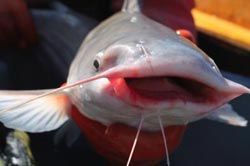Thinking 'big' may not be best approach to saving large-river fish

The fate of the blue catfish and more than 60 other species of large-river specialist fishes depends on conservation of suitable habitat and connectivity between the Mississippi River and its tributaries.<br><br>Credit: Brenda Pracheil<br>
The study says 60 out of 68 U.S. species, or 88 percent of fish species found exclusively in large-river ecosystems like the Mississippi, Missouri and Ohio rivers, are of state, federal or international conservation concern. The report is in the April issue of the journal Frontiers in Ecology and the Environment.
On the other hand, says lead author Brenda Pracheil, a postdoctoral researcher in the UW's Center for Limnology, the study offers some good news, too.
Traditionally, the conservation emphasis has been on restoring original habitat. This task proves impossible for ecosystems like the main trunk of the Mississippi River — the nation's shipping, power production, and flood control backbone. While the locks, dams and levees that make the Mississippi a mighty economic force have destroyed fish habitat by blocking off migration pathways and changing annual flood cycles species need to spawn, removing them is not a realistic conservation option.
But, says Pracheil, we're underestimating the importance of tributaries. Her study found that, for large-river specialist fish, it's not all or nothing. Some rivers are just big enough to be a haven.
For any river in the Mississippi Basin with a flow rate of less than 166 cubic meters of water per second, virtually no large-river specialist fishes are present. But in any river that even slightly exceeds that rate, 80 percent or more of the large-river species call it home.
That means Mississippi tributaries about the size of the Wisconsin River and larger are providing crucial habitat for large-river fishes. When coupled with current efforts in the large rivers themselves, these rivers may present important opportunities for saving species.
“Talk to any large-river fish biologist, and they will tell you how important tributaries are to big river fish,” says Pracheil. “But, until now, we've not really understood which rivers are most important. Our study tackles that and shows which tributaries in the Mississippi River Basin show the most promise for conservation of large-river fishes.”
Current policies governing large river restoration projects are funded largely through the U.S. Army Corps of Engineers, which requires that funds be spent on mainstems — or the big rivers themselves. Pracheil's study suggests spending some of that money on tributary restoration projects might do more conservation good for fish, while also letting agencies get more bang for their habitat restoration buck.
“Tributaries may be one of our last chances to preserve large-river fish habitat,” Pracheil says. “Even though the dam building era is all but over in this country, it's just starting on rivers like the Mekong and Amazon — places that are hotspots for freshwater fish diversity. While tributaries cannot offer a one-to-one replacement of main river habitats, our work suggests that [they] provide important refuges for large-river fishes and that both main rivers and their tributaries should be considered in conservation plans.”
Adam Hinterhuer, 608-890-2187, hinterthuer@wisc.edu
Media Contact
More Information:
http://www.wisc.eduAll latest news from the category: Ecology, The Environment and Conservation
This complex theme deals primarily with interactions between organisms and the environmental factors that impact them, but to a greater extent between individual inanimate environmental factors.
innovations-report offers informative reports and articles on topics such as climate protection, landscape conservation, ecological systems, wildlife and nature parks and ecosystem efficiency and balance.
Newest articles

Machine learning algorithm reveals long-theorized glass phase in crystal
Scientists have found evidence of an elusive, glassy phase of matter that emerges when a crystal’s perfect internal pattern is disrupted. X-ray technology and machine learning converge to shed light…

Mapping plant functional diversity from space
HKU ecologists revolutionize ecosystem monitoring with novel field-satellite integration. An international team of researchers, led by Professor Jin WU from the School of Biological Sciences at The University of Hong…

Inverters with constant full load capability
…enable an increase in the performance of electric drives. Overheating components significantly limit the performance of drivetrains in electric vehicles. Inverters in particular are subject to a high thermal load,…





















